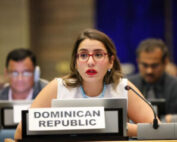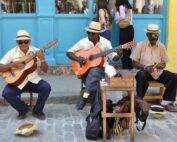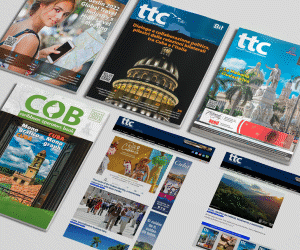Cuba: A Caribbean destination for sea adventurers
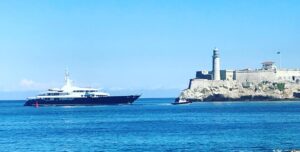
By Daily Pérez Guillén
___________________________
María Romeu, a highly experienced travel agent in the luxury yacht market, presents Cuba as a budding tourist destination with ample opportunities to gain a significant place in the Caribbean region.
___________________________
Right where the waters of the Atlantic Ocean, the Caribbean Sea, and the Gulf of Mexico converge, Cuba stands out as a key point for marine exploration and connectivity. More than 4,000 cays and islets, along with the Island of Cuba and the Isle of Youth, make up the largest and westernmost archipelago of the Greater Antilles. Those seeking adventure and privacy while traveling aboard luxury yachts will discover unforgettable experiences here.
Ranking among the eight largest archipelagos in the world has not guaranteed the Caribbean country one of the most visited nautical destinations in the Americas. María Romeu, a travel agent who has organized around fifty luxury yacht cruises across Cuba over the last decade, has tried to overcome all obstacles and turn this reality into an attraction.
Passion emerges when she talks about the subject. “Cuba offers, especially to the adventurous visitor, everything you can imagine. There are beautiful sailing routes because it is one of the largest, most diverse, and most pristine destinations in the entire Caribbean, for people who truly want to explore.”
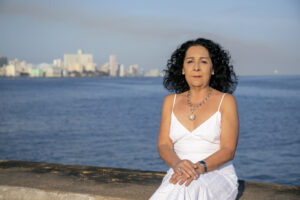
María Romeu, an experienced travel agent who has guided luxury yacht trips in Cuban waters.
A sustained commitment to environmental conservation means that approximately 25% of the marine and coastal ecosystems in this territory are recognized as protected areas. Hence, the seabed surrounding Cuba is ranked among the most spectacular in the Caribbean for its natural, historical, and scenic richness.
This is part of the promotional content highlighted by CubaPlus Travel, the company Romeu currently works for. “36% of all coral reefs in the Caribbean basin are found here… the ecosystems are healthier than in any other country,” the website’s home page states.
Most of these corals grow in pristine reservoirs. The reefs boast more than 40 species, and the largest black coral reserve in the Caribbean is located on the Guanahacabibes Peninsula, toward the western end of the island. Iconic species such as lionfish, grouper, conch, sea turtles, bottlenose dolphins, crocodiles, and sharks also swim in these depths.
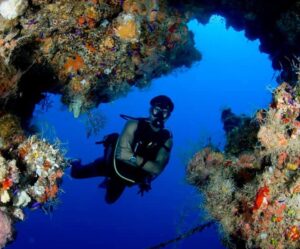
Diving experiences in María la Gorda.
In other locations, the underwater landscape offers caves, tunnels, and canals ideal for professional diving and photography, such as María la Gorda and Punta Francés. Meanwhile, in the Ciénaga de Zapata National Park, underground valleys and galleries connect to the sea through cenotes and lagoons.
As if that weren’t enough, Cuba also safeguards a submerged historical heritage. Specialized guidebooks and travel reviews mention the ship graveyards in the Bajo de Zambo area, with more than one hundred wrecks, or in the Bay of Santiago de Cuba, where Spanish ships sunk by American gunboats during the 1898 war lie.
To reach these places with all kinds of guarantees and enjoy exclusive experiences, María Romeu has designed three maritime routes—and announces that another one will soon be available along Cuba’s northern coast.
You can access them and learn all kinds of details through the digital platforms of the CubaPlus Travel agency. The Northwest route begins—or ends, like all the others, at the client’s choice—in Varadero, continues toward Havana, then continues to Cayo Jutías until reaching the María La Gorda International Diving Center, very close to Cape San Antonio, on the western tip of the island.
Meanwhile, one of the southwest routes begins at Cape San Antonio, then arrives at the María La Gorda International Diving Center, continues to Punta Francés on the Isle of Youth, enters the Canarreos Archipelago, skirts Cayo Largo del Sur, and continues to Cienfuegos and Trinidad.
Finally, the exploration that departs from Santiago de Cuba, on the southeast coast, offers a chance to enjoy the scenery at Marea de Portillo. Sailing at night is recommended, waking up in complete solitude on Cayo Cabeza del Este with a lighthouse in sight. Then, explore the Jardines de la Reina, and approach Trinidad, Cienfuegos, or Cayo Largo del Sur.
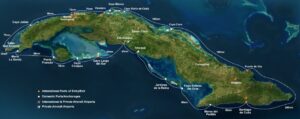
Sailing routes through Cuban waters.
EXCLUSIVE EXPERIENCES
Inland from the 5,800 km of coastline that will always be visible to the crews, the island territory is home to mountains, crystal-clear rivers with waterfalls, and diverse ecotourism trails; more than 6,000 plant species, many of which are endemic; iconic animals such as the smallest bird on the planet, the bee hummingbird; polymitas, the world’s most colorful snails, and the largest mangrove forests in the Caribbean.
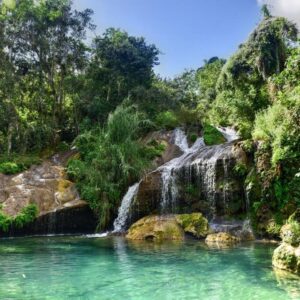
Waterfalls in the mountains of Cienfuegos, Cuba.
To ensure her discerning clients can experience these wonders, including the nation’s history, culture, and people, Romeu weaves a network of connections across the island with state and private stakeholders. “For example, I had a 99-meter yacht, with two passengers on board and 35 crew members, for thirty days off the southern coast of Cuba, just exploring. They never set foot on the mainland. They were British people of very high economic standing.”
She assures us that their stay went unnoticed. “These people seek privacy and the exploration of unspoiled places. They spent six days in Jardines de la Reina, an underwater national park protected for thirty years. There is every imaginable marine life, between seven and eight species of sharks and crocodiles endemic to Cuba. They then went to Cayo Largo del Sur, and to stock up, we managed to import 600 kilograms of gourmet food through a Belgian company. Everything was packaged in accordance with international regulations and requirements for food transportation. The Cuban entities Palco, Immigration, Customs, and Marinas Marlin collaborated with all the information and paperwork to move these supplies from Charles de Gaulle Airport in Paris to Cayo Largo del Sur in 72 hours. This was a wonderful experience in 2023, and we have already repeated it several times.”
Other travelers prefer to abandon their luxurious vessels for a few hours or days, explore selected locations in the country, and experience its vibrant culture.
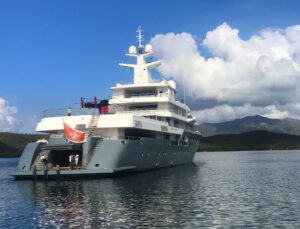
“In Santiago de Cuba, we hosted a spectacular yacht for four days. Its owners wanted a very curated, special trip, as it was one of their birthdays. During that time, we hosted a carnival at El Morro with the Comparsa del Caribe. Four children with two nannies and six other adults were also on board. On one occasion, while the adults enjoyed a private meeting with the city curator and musicologist, Omar López, about the history of Cuban music, the children took a class with the Santiago Ballet. And after the parents danced rumba in an interactive class, we went to the ballet studio and saw their children, both girls and boys, performing a scene from The Nutcracker. I think there were six private events in four days.”
Among the photos she keeps in her smartphone gallery are dinners held in such idyllic locations as the ruins of French coffee plantations in Gran Piedra, surrounded by flowers in the Ave del Paraíso Garden (Bird of Paradise Flower), where these Asian and many other species are grown. On pristine white tablecloths, silver cutlery, fine crystal glasses, and delicious meals gleam.

“All of this generates income for the private sector, for artists, and for the community at large, and it’s very important to me to support these people,” she declares.
CUBA, AN IDEAL SETTING FOR LUXURY YACHTING
Luxury yachting represents much more than sailing; it’s an exclusive way of life that combines advanced technology, refined design, and personalized experiences. María Romeu started in this business decades ago. Although she was born into a family of Cuban origin with nautical traditions, for the first time in her life she came close to modern vessels measuring 70, 80, and 90 meters in length, with helicopters, swimming pools, gyms, spas, and crews of up to 30 people on board.
“I would look at them and think, why don’t these yachts go to Cuba? One day, a British billionaire, a very famous financier, arrived with his wonderful boat that often went to that marina, and I asked the captain, do you think yachts like these would ever go to Cuba?” He replied, “Good luck. If you can convince a billionaire to take his yacht to Cuba, I think they’d love it, but I wouldn’t even know where to start.”
Years passed, and the idea continued to float in this woman’s head, who left her position in the marina to become a professional crew member. “I decided I was going to learn the industry from top to bottom and found a new career as a crew member on super-high-level yachts.”
It was then, after a long voyage, in December 2014, that she heard President Barack Obama’s statements that temporarily changed the course of relations between Cuba and the United States. “I left everything and, with a cousin, began visiting all the marinas in Cuba. I’ve spent ten years creating all this,” she says, while trying to get the sailing routes she’s designed to attract luxury yachts to Cuba to appear on her cell phone.
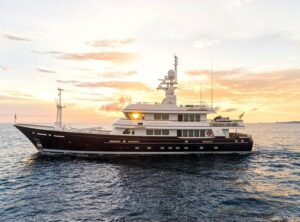
Yacht in Cuban waters.
Between 2016 and 2018, the company managed the voyage of more than 30 vessels of this type through Cuban waters and ports. It also organized a familiarization trip for the International Yacht Brokers Association and brought 27 charter yacht managers to Cuba in early 2017.
Following the intense hurricane season of 2018 and the restrictions imposed by the Donald Trump administration in 2019, which limited travel by US citizens to Cuba, she estimates that only about 20 yachts have booked her services. Given this reality, she redirected all her marketing to Europe, a strategy that is in line with the trends in this market.
Specialized media outlets claim that this industry is booming, driven by the growth of exclusive tourism, rising global wealth, and a growing demand for personalized experiences at sea. The luxury yacht market was valued at $8.75 billion in 2024 and is projected to grow to $10.14 billion in 2025. By 2033, it is expected to reach $17.33 billion, at an annual growth rate of 8.0%. Europe leads the trend with a 47.58% share, according to statistics from the previous year published by Fortune Business Insights.
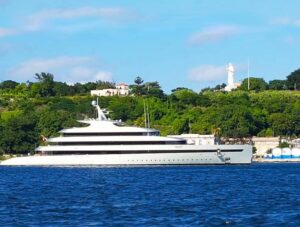
Superyacht entering the port of Havana.c
This high-end tourism generally seeks destinations in the Mediterranean, the Caribbean, and Southeast Asia. During the winter season (November to May), when warm temperatures and calm waters are ideal for sailing and anchoring, the Caribbean is the preferred destination. More than 700 islands and cays, from the Bahamas to the Virgin Islands, showcase unique landscapes and beaches and a very attractive local culture.
Many of these islands are only accessible by boat, a guarantee of privacy and exclusivity highly valued by the small but significant percentage of travelers who make up this segment. As an essential addition, the region’s modern marinas offer high-end charter services and professional crews.
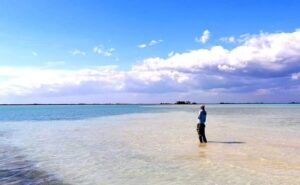
In this competitive and exclusive environment, Cuba still offers opportunities and challenges. María Romeu knows them very well.
“Yachting is totally mobile in every aspect. The restrictions that exist in the United States only apply to American yachts. The last one we had here was Moroccan-owned, but the vessel was Italian. That yacht lives half the year in a Miami marina, and it came and went there. The border guard and the border police told it, “Welcome,” because the restrictions are on American owners and vessels, which number eight or ten. The rest of the yachts in the world are not made in the United States, nor are their owners American citizens.
Given this reality, what options remain for American citizens who want to sail through Cuba’s seas and even get closer to its people? While tourist travel is not authorized under current Cuban legislation, the Office of Foreign Assets Control (OFAC) has issued general licenses for twelve categories of travel.
“With an itinerary that qualifies in these categories, they can come,” Romeu clarifies. “Many Americans have come mainly under the so-called Support for the Cuban People and Humanitarian Projects programs, for whom I have created itineraries and experiences related to nature conservation, seabed protection in protected areas, and others. I had a family, for example, whose entire experience was with private cultural projects. That means Americans can also come legally.”
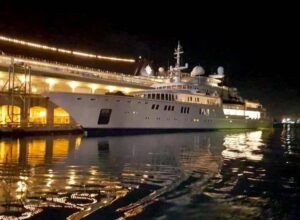
Superyacht in the port of Havana.
Despite the difficult economic situation Cuba is experiencing, the experienced travel agent assures that the country is better able than ever to promote high-standard tourism.
“During our stays in Cuba, we heavily promote natural products. We work with agroecological farms, offering natural, seasonal, and all organic products. But if they ask for a pear that doesn’t grow in Cuba, there are suppliers who import, and you can find pears, apples, and grapes. We hire people who supply restaurants daily, and we can legally provide fresh fish, different types of milk, even gourmet food. There are very few things that are unavailable, such as exotic vinegars or oils. But these crews travel with a chef on board, and we work closely with them on supplies. They love cooking with what we provide here.
María also makes sure her clients venture ashore. “We take excursions to farms like Vista Hermosa or Marta. At the sustainable restaurant El Cuajaní in Viñales, for example, they have an impressive garden where they grow countless different types of tomatoes and are dedicated to edible flowers. Savoring the tostones made with a variety of Italian tomatoes or the cilantro flower skewers that explode in your mouth are unforgettable experiences with the flavor of the Cuban countryside.”
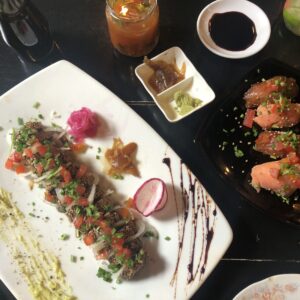
Gastronomic delights at a private Cuban restaurant.
Fuel, a major concern in the country today, is not so much of a concern for CubaPlus Travel. “These are vessels with large tanks that almost never need refueling.” In any case, the agency has ensured it has the support of the country’s infrastructure for emergencies.
“If something breaks, a satellite, an engine part, we can get it into Cuba in less than 24 hours. We have the full support of Customs and the marinas. I’ve had to locate everything from medicines to satellites, or a propeller, and we’ve been able to get it into Cuba and onto the yacht within 24 hours.”
Regarding nautical infrastructure in the archipelago, the Marina Gaviota Varadero, with more than 1,000 berths, is one of the largest in the Caribbean. The Port of Havana, which also serves as a gateway to unique cultural experiences such as the Cannon Shot Ceremony at La Cabaña Fortress or the Tropicana Cabaret show, is well-equipped to accommodate these luxury yachts. In other areas of the vast island, such as Cayo Largo, Cienfuegos, and Santiago de Cuba, there are other points also equipped for these purposes. A network of anchorages complements these facilities in key locations on the island’s shelf.
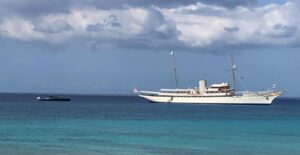
Yacht in María la Gorda.
In communicating these opportunities for adventure and exploration in Cuba and participating in networking events like nautical shows, Romeu sees a goal. These types of events attract merchants, members of professional yachting organizations, captains, as well as representatives from many other agencies dedicated to mapping out routes for luxury yachts.
“It’s very important to understand the impact of this level of visitors, because if they are conscious people who come to Cuba truly to soak up or be immersed in the culture and nature, it’s with the hope of a new level of tourism, and they also serve as ambassadors,” says María Romeu, a woman who thinks of her people and of positioning Cuba as one of the preferred destinations for luxury yachting in the Caribbean. “The most important thing for me is that these types of people come and see and know that they are safe and healthy, that they will be welcomed with open arms.”

MORE NEWS









